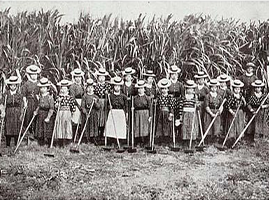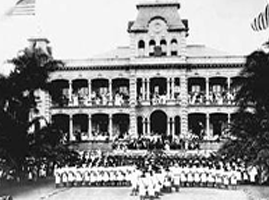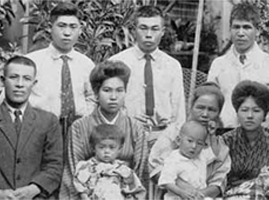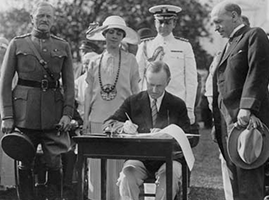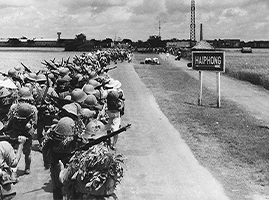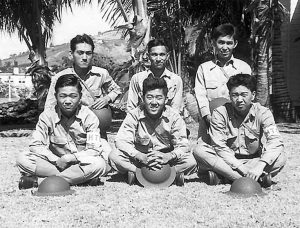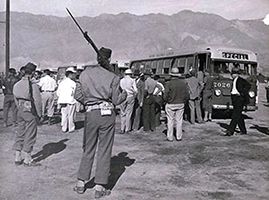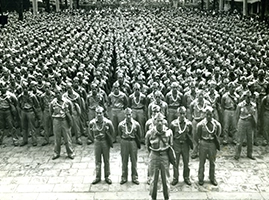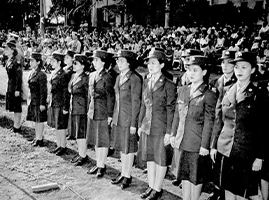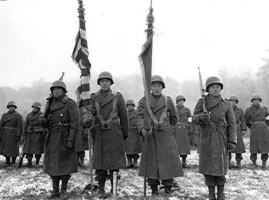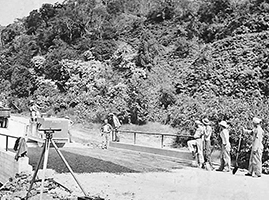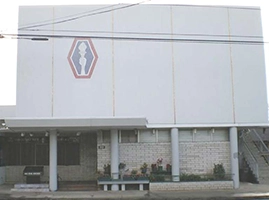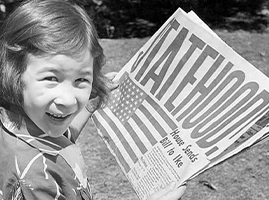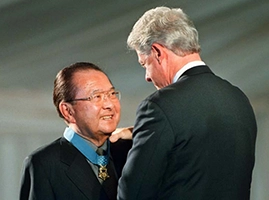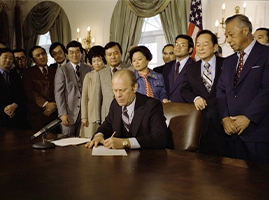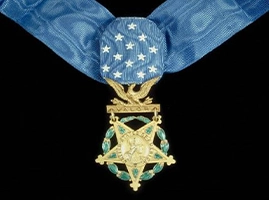After Japan’s surprise attack on Pearl Harbor, distrust of Americans of Japanese Ancestry (AJA) escalated, both in Hawaii and on the mainland, albeit much more intensely on the mainland. AJAs in Hawaii faced constant questions about their loyalties, along with blatant social, legal and economic discrimination.
Immediately after the attack on Pearl Harbor on December 7, 1941, President Franklin Delano Roosevelt signed Proclamation 2525, allowing the government to detain enemy aliens and confiscate enemy property. By the next morning, 391 people of Japanese ancestry had been apprehended.
“The most effective fifth column work of the entire war was done in Hawaii.” — Frank Knox, former Secretary of Navy
Hawaii’s first internment camps opened in Hawaii on December 8, 1941. Eventually, some 2,000 people of Japanese ancestry in Hawaii would be interned. Yet unlike mass internment that occurred on the mainland, the authorities in Hawaii were more supportive and were aware of AJA’s criticality to the war effort and Hawaii’s economy, so only one percent of the population ended up in camps.
Still, AJAs in Hawaii encountered prejudice from the highest levels of the US government.
U.S. Secretary of Navy Frank Knox visited Hawaii a week after Pearl Harbor. After spending 36 hours in the islands, he issued a report to the President calling for mass incarceration or removal of Japanese in Hawaii, referring to them as a “fifth column.” He accused local Japanese of deliberately misleading defenders at Pearl Harbor and continued to repeat these charges, even after the FBI and Army Intelligence said there had been no sabotage during or after the attack. Despite Knox’s persistence, Lt. Gen. Delos Emmons, Hawaii’s military governor under martial law, was able to convince the Administration to impose very selective detention, as opposed to a mass forced evacuation and incarceration.
Discrimination of Americans of Japanese Ancestry took various forms as the country went to war. On January 5, 1942, the US military draft system declared AJAs as 4-C aliens (category 4C), and therefore not eligible to be drafted into military service. This was a huge blow to the AJAs who were eager to enlist.
Shortly thereafter, on January 21, 1942, AJAs were dismissed without explanation from the Hawaii Territorial Guard, which had been mobilized after Pearl Harbor to protect vital civilian installations. Yet, AJAs remained committed to contributing to the country’s war efforts.
After the Territorial Guard was inactivated, the discharged guardsmen petitioned the military governor Lt. Gen. Emmons "for whatever service you may see fit to use us," and organized themselves as the Varsity Victory Volunteers (VVV). Their offer was accepted by the Army and on February 25, 1942, the VVV began work as a labor battalion. A year later, their work as the VVV was a significant influence on President Roosevelt’s decision to form the 442nd Regimental Combat Team.
Morale Section of Governor's Office established
On Dec. 18, 1941, the Morale Section of the Military Governor's Office was established, headed by Shigeo Yoshida, Hung Wai Ching and Charles Loomis. Under the Morale Section, various organizations were formed within different ethnic communities, including the Emergency Service Committee, which worked with the Japanese-American community. The purpose of this organization was to “channel the inherent loyalty of the people of Japanese ancestry into a program of active participation in the war effort.”
Eager to show their loyalty during wartime, the Committee launched a “Speak-American” campaign, organized blood drives and collected funds for the Red Cross and the Army and Navy Emergency Relief Societies. These activities were focused on maximizing AJA involvement in the war effort and minimizing the potential for a mass internment decision. The results of their efforts clearly revealed the core patriotism of the Japanese-American community. It also exposed the underlying fear of AJAs, as they became targets of anti-Japanese discrimination by many Caucasians.
Meanwhile: Japan Occupies the Philippines
As AJAs in Hawaii struggled to overcome various challenges, the war raged on.
Ten hours after the Pearl Harbor attack, Japan invaded the Philippines. American aircraft had been severely damaged during this assault, and the American Asiatic Fleet in the Philippines withdrew to Java. On January 2, 1942, Japan invaded the Philippines and would remain there for more than three years until Japan’s surrender.
The Battle of Bataan began five days after Japan’s initial invasion of the Philippines. Imperial Japanese forces landed on Luzon and several other Philippine islands. General Douglas MacArthur, commander of Filipino and US forces in the islands, consolidated his forces on the Bataan Peninsula to defend against the numerically superior Japanese invasion forces. After resisting for three months, the combined US and Filipino forces surrendered on April 9, 1942 — the largest surrender in US history. Shortly after, 60,000 Filipino and 15,000 US soldiers were forced to march 60 miles to Camp O’Donnell, a tortured journey known as the Bataan Death March. Soldiers were subjected to severe physical abuse and killings which were later deemed Japanese war crimes.
On May 8, 1942, at the conclusion of the Battle of Corregidor, the U.S. Army in the Philippines surrendered to Japan.

Sand Island detention camp

Honouliuli detention camp

Frank Knox

Shigeo Yoshida, Hung Wai Ching and Charles Loomis

Lt. General Delos C. Emmons
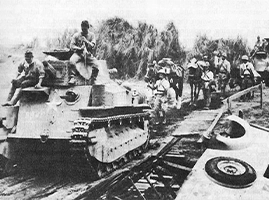
Japanese army invades Philippines

Incarcerated as enemy aliens

Bataan Death March

Hawaii Territorial Guard members

U.S. Army Transport General Royal T. Frank

Corregidor surrenders
Japanese American Responses to Incarceration

Events (Dec 1941 – May 1942)
Under the authority of Presidential Proclamation 2525, issued on Dec. 7, 1941, the U.S. Army and the FBI carry out arrests and detention of Issei and Nisei who were on previously prepared "detention lists." By the next morning, 391 persons of Japanese ancestry had been apprehended.
Sand Island Camp open in Honolulu for about 400 arrested Issei and Nisei, followed days later by camps on the Big Island, Oahu, Maui and Kauai.
Secretary of Navy Frank Knox visits Hawaii on December 11 and 12, 1945, to assess the situation. In his report on this visit, he calls for mass removal/incarceration of people of Japanese ancestry in Hawaii.
Prominent local leaders in Hawaii, Hawaii's military governor (Lt. Gen. Delos Emmons), and FBI Director J. Edgar Hoover argue successfully against mass relocation of Hawaii Japanese.
Japanese military forces occupy Manila in the Philippines.
The US Military draft system declares AJAs as 4-C aliens (category 4C), and therefore not eligible to be drafted into military service.
After three months of intensive fighting on the Bataan peninsula, US and Filipino forces surrender on April 9, 1942, the largest surrender in US history. Some 60,000 Filipino and 15,000 American POWs are forced into a 60-mile Bataan Death March.
AJAs serving in the Hawaii Territorial Guard are dismissed without explanation.
The troop ship USAT Royal T. Frank is torpedoed while ferrying trainees from Oahu to Hilo. Seventeen die in the submarine attack.
The Emergency Service Committee is assigned by the Morale Section of Military Governor's Office to work with the Japanese community.
The Battle of Corregidor ends with the surrender of all US forces in the Philippines.
PHOTOS COURTESY OF:
U. S. National Archives and Records Administration
U. S. National Archives and Records Administration
U. S. National Archives and Records Administration
Katsugo Miho
United States Army Center of Military History
U. S. Army Signal Corps
U. S. Army Signal Corps
Library of Congress
R.H. Lodge Courtesy of Japanese Cultural Center of Hawaii
U. S. Army
Ted Tsukiyama
R.H. Lodge Courtesy of Japanese Cultural Center of Hawaii
U. S. Army
Library of Congress
U. S. Army Signal Corps
U. S. Army Signal Corps
United States Army Center of Military History
Katsugo Miho
U. S. National Archives and Records Administration
Ted Tsukiyama
U. S. National Archives and Records Administration
U. S. National Archives and Records Administration


